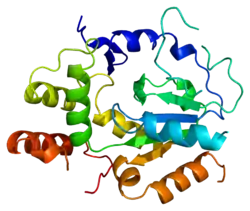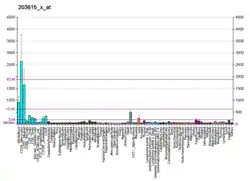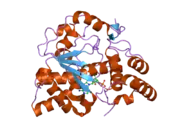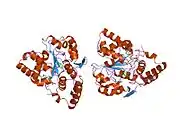SULT1A1
Sulfotransferase 1A1 is an enzyme that in humans is encoded by the SULT1A1 gene.[3][4][5]
Sulfotransferase enzymes catalyze the sulfate conjugation of many hormones, neurotransmitters, drugs, and xenobiotic compounds. These cytosolic enzymes are different in their tissue distributions and substrate specificities. The gene structure (number and length of exons) is similar among family members. This gene encodes one of two phenol sulfotransferases with thermostable enzyme activity. Multiple alternatively spliced variants that encode two isoforms have been identified for this gene.[5]
The SULT1A1 enzyme is expressed in outer roots sheath of hair follicles. Minoxidil, the only US FDA approved topical drug for re-growing hair in male and female pattern hair loss (androgenetic alopecia patients) is a pro-drug. Minoxidil is converted to its active form (minoxidil sulfate) by the hair sulfotransferase enzyme (SULT1A1).[6] A large variability in sulfotransferase enzyme expression in hair is observed among people. Low sulfotransferase activity was found to be predictive to lack of response to topical minoxidil for hair re-growth.[7] In a clinical study, a novel formula using a hypoxia mimetic pathway demonstrated to increase SULT1A1 activity in human subjects in-vivo.[8]
References
- GRCh38: Ensembl release 89: ENSG00000196502 - Ensembl, May 2017
- "Human PubMed Reference:". National Center for Biotechnology Information, U.S. National Library of Medicine.
- Dooley TP, Obermoeller RD, Leiter EH, Chapman HD, Falany CN, Deng Z, Siciliano MJ (November 1993). "Mapping of the phenol sulfotransferase gene (STP) to human chromosome 16p12.1-p11.2 and to mouse chromosome 7". Genomics. 18 (2): 440–3. doi:10.1006/geno.1993.1494. PMID 8288252.
- Dooley TP, Huang Z (November 1996). "Genomic organization and DNA sequences of two human phenol sulfotransferase genes (STP1 and STP2) on the short arm of chromosome 16". Biochemical and Biophysical Research Communications. 228 (1): 134–40. doi:10.1006/bbrc.1996.1628. PMID 8912648.
- "SULT1A1 sulfotransferase family 1A member 1 [ Homo sapiens (human) ]".
- McCoy J, Goren A, Naccarato T, Kovacevic M, Situm M, Skudar VL, Lotti T (2019). "Identification of the sulfotransferase iso-enzyme primarily responsible for the bio-activation of topical minoxidil". Journal of Biological Regulators and Homeostatic Agents. 33 (3): 817–819. PMID 31184104.
- Goren A, Shapiro J, Roberts J, McCoy J, Desai N, Zarrab Z, et al. (2015). "Clinical utility and validity of minoxidil response testing in androgenetic alopecia". Dermatologic Therapy. 28 (1): 13–6. doi:10.1111/dth.12164. PMID 25112173.
- Ramos PM, McCoy J, Wambier C, Shapiro J, Vañó-Galvan S, Sinclair R, Goren A (May 2020). "Novel topical booster enhances follicular sulfotransferase activity in patients with androgenetic alopecia: a new strategy to improve minoxidil response". Journal of the European Academy of Dermatology and Venereology. doi:10.1111/jdv.16645. PMID 32432358.
Further reading
- Weinshilboum RM, Otterness DM, Aksoy IA, Wood TC, Her C, Raftogianis RB (January 1997). "Sulfation and sulfotransferases 1: Sulfotransferase molecular biology: cDNAs and genes". FASEB Journal. 11 (1): 3–14. doi:10.1096/fasebj.11.1.9034160. PMID 9034160. S2CID 12532583.
- Windmill KF, Christiansen A, Teusner JT, Bhasker CR, Birkett DJ, Zhu X, McManus ME (February 1998). "Localisation of aryl sulfotransferase expression in human tissues using hybridisation histochemistry and immunohistochemistry" (PDF). Chemico-Biological Interactions. 109 (1–3): 341–6. doi:10.1016/S0009-2797(97)00144-0. PMID 9566757.
- Glatt H, Engelke CE, Pabel U, Teubner W, Jones AL, Coughtrie MW, et al. (March 2000). "Sulfotransferases: genetics and role in toxicology". Toxicology Letters. 112–113: 341–8. doi:10.1016/S0378-4274(99)00214-3. PMID 10720750.
- Glatt H (December 2000). "Sulfotransferases in the bioactivation of xenobiotics". Chemico-Biological Interactions. 129 (1–2): 141–70. doi:10.1016/S0009-2797(00)00202-7. PMID 11154739.
- Glatt H, Boeing H, Engelke CE, Ma L, Kuhlow A, Pabel U, et al. (October 2001). "Human cytosolic sulphotransferases: genetics, characteristics, toxicological aspects". Mutation Research. 482 (1–2): 27–40. doi:10.1016/S0027-5107(01)00207-X. PMID 11535246.
- Ozawa S, Nagata K, Shimada M, Ueda M, Tsuzuki T, Yamazoe Y, Kato R (1995). "Primary structures and properties of two related forms of aryl sulfotransferases in human liver". Pharmacogenetics. 5 Spec No: S135-40. doi:10.1097/00008571-199512001-00015. PMID 7581483.
- Jones AL, Hagen M, Coughtrie MW, Roberts RC, Glatt H (March 1995). "Human platelet phenolsulfotransferases: cDNA cloning, stable expression in V79 cells and identification of a novel allelic variant of the phenol-sulfating form". Biochemical and Biophysical Research Communications. 208 (2): 855–62. doi:10.1006/bbrc.1995.1414. PMID 7695643.
- Hwang SR, Kohn AB, Hook VY (February 1995). "Molecular cloning of an isoform of phenol sulfotransferase from human brain hippocampus". Biochemical and Biophysical Research Communications. 207 (2): 701–7. doi:10.1006/bbrc.1995.1244. PMID 7864863.
- Yamazoe Y, Nagata K, Ozawa S, Kato R (June 1994). "Structural similarity and diversity of sulfotransferases". Chemico-Biological Interactions. 92 (1–3): 107–17. doi:10.1016/0009-2797(94)90057-4. PMID 8033246.
- Falany CN, Zhuang W, Falany JL (June 1994). "Characterization of expressed human phenol-sulfating phenol sulfotransferase: effect of mutating cys70 on activity and thermostability". Chemico-Biological Interactions. 92 (1–3): 57–66. doi:10.1016/0009-2797(94)90053-1. PMID 8033270.
- Veronese ME, Burgess W, Zhu X, McManus ME (September 1994). "Functional characterization of two human sulphotransferase cDNAs that encode monoamine- and phenol-sulphating forms of phenol sulphotransferase: substrate kinetics, thermal-stability and inhibitor-sensitivity studies". The Biochemical Journal. 302 ( Pt 2) (2): 497–502. doi:10.1042/bj3020497. PMC 1137255. PMID 8093002.
- Zhu X, Veronese ME, Bernard CC, Sansom LN, McManus ME (August 1993). "Identification of two human brain aryl sulfotransferase cDNAs". Biochemical and Biophysical Research Communications. 195 (1): 120–7. doi:10.1006/bbrc.1993.2018. PMID 8363592.
- Wilborn TW, Comer KA, Dooley TP, Reardon IM, Heinrikson RL, Falany CN (January 1993). "Sequence analysis and expression of the cDNA for the phenol-sulfating form of human liver phenol sulfotransferase". Molecular Pharmacology. 43 (1): 70–7. PMID 8423770.
- Zhu X, Veronese ME, Sansom LN, McManus ME (April 1993). "Molecular characterisation of a human aryl sulfotransferase cDNA". Biochemical and Biophysical Research Communications. 192 (2): 671–6. doi:10.1006/bbrc.1993.1467. PMID 8484775.
- Her C, Raftogianis R, Weinshilboum RM (May 1996). "Human phenol sulfotransferase STP2 gene: molecular cloning, structural characterization, and chromosomal localization". Genomics. 33 (3): 409–20. doi:10.1006/geno.1996.0216. PMID 8661000.
- Bernier F, Soucy P, Luu-The V (May 1996). "Human phenol sulfotransferase gene contains two alternative promoters: Structure and expression of the gene". DNA and Cell Biology. 15 (5): 367–75. doi:10.1089/dna.1996.15.367. PMID 8924211.
- Raftogianis RB, Her C, Weinshilboum RM (December 1996). "Human phenol sulfotransferase pharmacogenetics: STP1 gene cloning and structural characterization". Pharmacogenetics. 6 (6): 473–87. doi:10.1097/00008571-199612000-00001. PMID 9014197.











